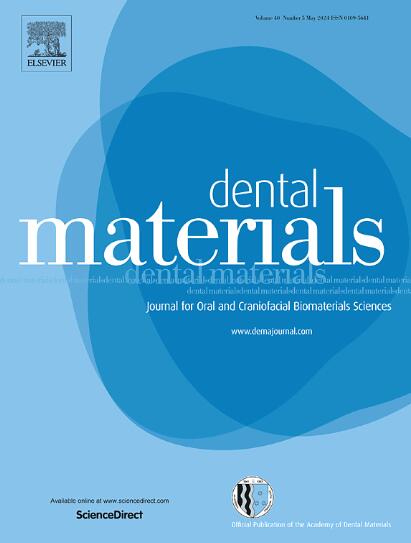我们是否即将开发出一种新型磷酸钙基生物陶瓷牙科材料?
IF 4.6
1区 医学
Q1 DENTISTRY, ORAL SURGERY & MEDICINE
引用次数: 0
摘要
目标:开发一种添加了二氧化钛(TiO2)纳米颗粒(重量百分比为 5%和 8%)的可持续牛羟基磷灰石牙科陶瓷:开发一种添加了二氧化钛(TiO2)纳米颗粒(按重量计分别为 5% 和 8%)的可持续牛羟基磷灰石牙科陶瓷,分析这种添加物对微观结构的影响及其机械和化学特性,以评估它们是否符合国际标准化组织(ISO)6872:2015 关于牙科陶瓷的标准:用牛羟基磷灰石粉末和二氧化钛纳米颗粒通过单轴等静压法获得牙盘,并在 1300ºC 下烧结 2 小时。实验分为三组(HA、HA+5 %TiO2 和 HA+8 %TiO2),并进行了 X 射线衍射(XRD)、扫描电子显微镜(SEM)、能量色散光谱(EDS)、压痕断裂(IF)、双轴抗折强度(BFS)和化学溶解度测试:XRD显示,HA组出现了与b-磷酸三钙(ß-TCP)相对应的峰值。在 HA+ 5 %TiO2 和 HA+ 8 %TiO2 组中,整个成分转化为 ß-TCP 和钙钛矿(CaTiO3)。扫描电子显微镜图像显示了致密的陶瓷基体和与二氧化钛纳米颗粒成组的另一种相的均匀分布。HA+ 5 %TiO2(1.40 ± 0.18 MPa.m1/2)和 HA+ 8 %TiO2(1.32 ± 0.18 MPa.m1/2)的断裂韧性值明显高于 HA(0.67 ± 0.09 MPa.m1/2)。与含有 5%(235.1 MPa) 和 8%(214.4 MPa) TiO2 纳米颗粒的组别相比,HA 的特征应力(295.8 MPa)明显更高。Weibull 模量值之间未发现差异。溶解度结果表明,所有实验陶瓷的溶解度均高于 ISO 6872:2015 规定的 2000 ug/cm2 限值:本研究提出了一种新型义齿陶瓷的开发和表征方法,该陶瓷由从牛骨中提取的 HA 制成,旨在重新利用这些固体废弃物,并将其转化为一种可持续的低成本材料。虽然添加了 5% 和 8% 二氧化钛的实验性磷酸钙陶瓷达到了理想的机械性能,但化学溶解度值非常高。本文章由计算机程序翻译,如有差异,请以英文原文为准。
Are we approaching the development of a novel calcium phosphate-based bioceramic dental material?
Objectives
Develop a sustainable bovine hydroxyapatite dental ceramic with the addition of titanium dioxide (TiO2) nanoparticles (5 % and 8 % by weight), analyzing the outcome of this addition to the microstructure, as well as its mechanical and chemical properties, in order to evaluate whether they satisfy the International Organization for Standardization (ISO) 6872:2015 for dental ceramics or not.
Methods
Disks were obtained through uniaxial followed by isostatic pressing from bovine hydroxyapatite powder and TiO2 nanoparticles and sintered at 1300ºC for 2 h. Three experimental groups were developed (HA, HA+5 %TiO2 and HA+8 %TiO2) and subjected to X-ray diffraction (XRD), scanning electron microscopy (SEM), energy dispersive spectroscopy (EDS), indentation fracture (IF), biaxial flexural strength (BFS) and chemical solubility test.
Results
XRD revealed, for HA group, the appearance of a peak corresponding to b-tricalcium phosphate (ß-TCP). For HA+ 5 %TiO2 and HA+ 8 %TiO2, the entire composition was converted into ß-TCP and calcium titanate (CaTiO3). The SEM images showed a dense ceramic matrix and a uniform distribution of another phase in groups with TiO2 nanoparticles. HA+ 5 %TiO2 (1.40 ± 0.18 MPa.m1/2) and HA+ 8 %TiO2 (1.32 ± 0.18 MPa.m1/2) showed significantly higher fracture toughness values than HA (0.67 ± 0.09 MPa.m1/2). HA showed significantly higher characteristic stress (295.8 MPa) in comparison to groups with 5 % (235.1 MPa) and 8 % (214.4 MPa) TiO2 nanoparticles. Differences were not observed between the Weibull modulus values. The solubility results indicated that all experimental ceramics were above the 2000 ug/cm2 limit set by the ISO 6872:2015.
Significance
This study proposed the development and characterization of a new ceramic for dental prosthesis made from HA extracted from bovine bones, with the intention of reusing these solids waste and transforming them into a sustainable and low-cost material. Although the experimental calcium phosphate ceramic with additions of 5 % and 8 % of TiO2 achieved desirable mechanical properties, the chemical solubility values were very high.
求助全文
通过发布文献求助,成功后即可免费获取论文全文。
去求助
来源期刊

Dental Materials
工程技术-材料科学:生物材料
CiteScore
9.80
自引率
10.00%
发文量
290
审稿时长
67 days
期刊介绍:
Dental Materials publishes original research, review articles, and short communications.
Academy of Dental Materials members click here to register for free access to Dental Materials online.
The principal aim of Dental Materials is to promote rapid communication of scientific information between academia, industry, and the dental practitioner. Original Manuscripts on clinical and laboratory research of basic and applied character which focus on the properties or performance of dental materials or the reaction of host tissues to materials are given priority publication. Other acceptable topics include application technology in clinical dentistry and dental laboratory technology.
Comprehensive reviews and editorial commentaries on pertinent subjects will be considered.
 求助内容:
求助内容: 应助结果提醒方式:
应助结果提醒方式:


